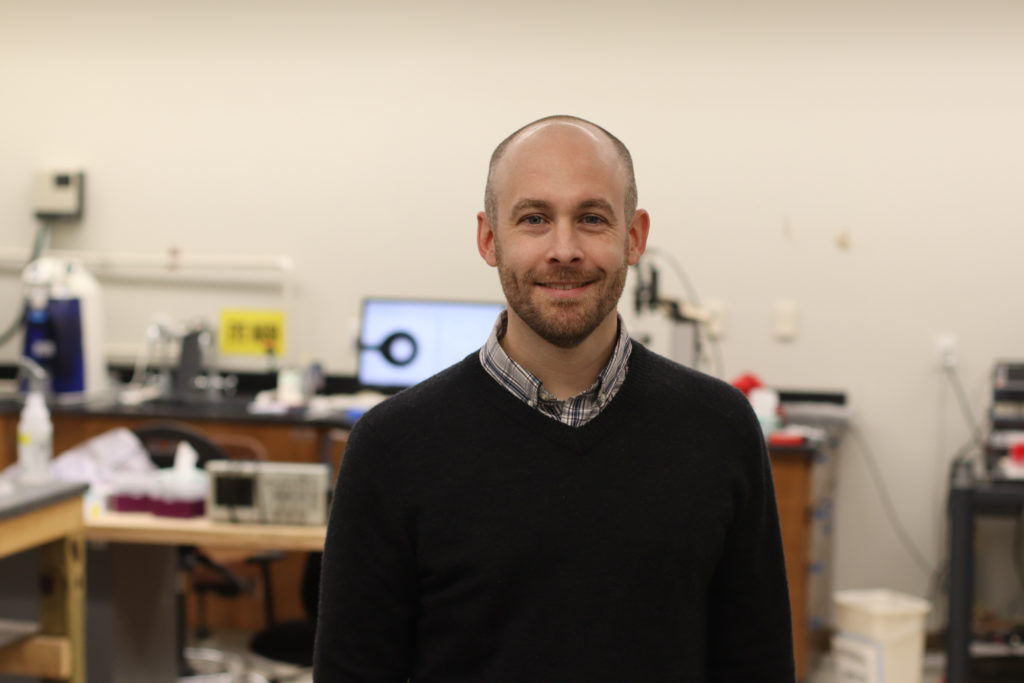
The quest for smarter, more self-reliant vehicles and machines has picked up steam in recent years, with autonomous devices seemingly within reach.
One of the keys to such technology is the need for machines to be able to learn the best ways to operate, with the goal of having to rely on human input as little as possible.
Associate Professor Andy Sarles is playing a vital role in research seeking to improve such functionality by taking an approach notably different from past efforts.
“Artificial intelligence and machine learning most commonly use software and algorithms to operate, which, in turn, requires large amounts of data,” said Sarles, who works in the Department of Mechanical, Aerospace, and Biomedical Engineering. “We want to use hardware to enable machines that learn on their own, without the need for human-guided training. That’s our pie-in-the-sky goal, to have vehicle systems with autonomous brain-like computing.”
This kind of processing is known as neuromorphic computing, which instead of software involves using hardware components, such as memristors, which are variable resistors that remember, to mimic the neurons and synapses found in the brain.
Sarles first began working on neuromorphic systems in collaboration with Associate Professor Garrett Rose of the Min H. Kao Department of Electrical Engineering and Computer Science and Oak Ridge National Laboratory’s Pat Collier in a recently completed NSF project that examined the use of soft biomolecular membranes as “wet-ware” mimics of neural synapses.
Using that work as a building block, the next big challenge for Sarles was finding ways to combine different molecules to engineer a property called plasticity.
“Synaptic plasticity in the brain is the way in which connections between neurons strengthen and weaken on demand, allowing for adjustable signal processing and communication. This is what gives us the capacity to learn, forget, relearn and remember over time,” Sarles said. “We are studying materials that exhibit similar types of plasticity, and we hope this will allow for hardware that can compute, learn and remember.”
In his bio-inspired wet-ware, he is developing materials that achieve voltage-activated plasticity via lipid membranes and ion channels—just like in real neurons. By connecting those materials to solid-state circuitry, Sarles’ team is creating hybrid neural networks that mimic how neurons communicate via action potentials at adaptable synapses.
Another advantage of the biomolecular approach Sarles is taking is that the range of functions that can be obtained by combining various types of voltage-activated biomolecules—each component is nano-scale.
“It’s a uniquely modular system, one where we can mix and match components to shape the outcome,” Sarles said. “It gives us tons of control in tuning performance and developing better understanding of the underlying physics, especially when compared to more traditional oxide-based devices.”
All of this comes with Sarles as part of a wider team working together across several universities as part of a Multidisciplinary University Research Initiative (MURI) grant awarded by the US Department of Defense.
The wide-ranging project, “Brain-Inspired Networks for Multifunctional Intelligent Systems in Aerial Vehicles,” resulted in more than $7.5 million in funding from the Air Force Office of Scientific Research, with Sarles slated to receive $830,000 in support over five years.
The goal is to use Sarles’ synapse and neuron inspired materials in unmanned aerial vehicles that can think about their flight patterns, react to data they collect, and improve their operational capabilities by learning from current and past experiences.
UCLA serves as lead on the overall project, with researchers at Stanford University, the University of Michigan, Texas A&M University, and the University of Massachusetts at Amherst all taking part, in addition to UT’s role.